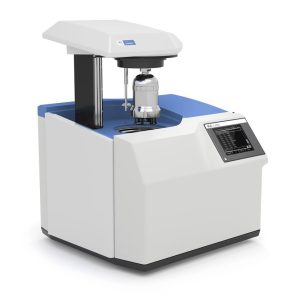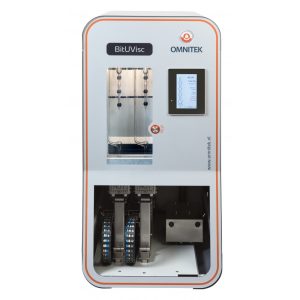Automatic Microscale Continuously Closed Cup Flash Point Analyzer
Thương hiệu: Koehler
LIÊN HỆ MUA HÀNG: 02866525193
100-240V 50/60Hz, 300 W
wxdxh,in.(cm): 8.9 x 12.2 x 16.3 (22.5x31x41.5)
Net Weight: 26.5 lbs (12kg)
Xem thêm >>> https://ilabvn.com/product-category/koehler/application-industry/
ASTM D6450: For determination of flash point of fuel oils, lube oils, solvents and other liquids by continuously closed cup tester. The measurement is made on a test specimen of 1 mL and utilizes a closed but unsealed cup with air injected into the test chamber. This method is suitable for testing samples with a flash point from 10 °C to 250 °C.
ASTM D7094: For determination of flash point of fuels including diesel/biodiesel blends, lube oils, solvents, and other liquids by a continuously closed cup tester utilizing a specimen size of 2 mL, cup size of 7 mL, with a heating rate of 2.5 °C per minute. This test method utilizes a closed but unsealed cup with air injected into the test chamber and is suitable for testing samples with a flash point from 35 °C to 225 °C.
Under specified test conditions, when a sample is heated to the temperature called flash point, the sample vapor and air mixture are ignited instantly. Flash Point is one of the indicators for the evaluation of a materials’ combustion tendency. If the flash point Is low, the combustion risk would be high. As for transport and safety regulation, flash point is used for the classification of “flammable liquids”. Also, flash point is used for quality control index or determining the existence of highly volatile or flammable substances in relatively nonvolatile or nonflammable matter, e.g. lubricant mixed with a small amount of diesel or gasoline.
The Koehler K24880 Microscale Continuously Closed Cup Flash Point Tester works in the following manner. The temperature of the analyzer is adjusted to at least 18 °C below the expected flash point. The sample is injected into the sample cup. The operator must ensure that the sample and sample cup temperature are both at least 18 °C below the expected flash point (the sample and sample cup may be cooled if necessary). Then the sample cup is raised towards the oven forming a closed test chamber, which is not sealed.
After every ignition, the proper volume of air goes into the test chamber to supply the next ignition with oxygen to burn. The pressure in the unsealed closed test chamber should be ambient atmospheric pressure, except during the short period of air introduction and the time when the flash point is achieved. The pressure increase comes after discharge of air, so each time after the air discharges, the chambers pressure is higher than ambient atmospheric pressure. When the pressure increase exceeds the specified limit, this is recorded as the flash point temperature (which has not been corrected).
Conforms to the specifications of:
ASTM D6450 and D7094
Excellent Correlation to: ASTM D93, D3828; EN ISO 6379 / 3680; ISO 2719; SH/T 0768, SH/T 3077.1, SH/T 3077.2, DL/T 1354, GB/T 261, GB/T 21615, GB/T 5208, GB/T 21790
Temperature Range: -30 °C to 405°C (-22 °F to 788 °F) below 0 °C an external cryogenic recirculatory is required
Heating Rate: 2.5 °C/min ± 0.3 °C/min or 5.5 °C/min ± 0.5 °C/min; can be customized in the range of 0.5 to 12 C/min
Temperature Accuracy: ± 0.1 °C
Pressure Range: 0 kPa to 200 kPa
Sample Volume: 1 mL or 2 mL
Ignition method: High voltage electric ignition
Stirring Rate: Can be customized from 50 RPM to 300 RPM
Interfaces: RS232, USB, Ethernet
- Automatic determination of flash points
- Automatic corrections for ambient atmospheric
- Required amount of sample for each test is 1 mL or 2 ml
- Less sample demand, lower test cost and less pollution
- Continuously closed cup operation with high safety and no open flame
- Built-in refrigeration module with high efficiency
- 7-inch Integrated Color Touch Screen
- Built-in standard test methods which can be correlated to other closed cup methods
- Real-time display of temperature and pressure curves
- RS232 interface for connection to thermal printer
- USB interface for connection with mouse or storage device
- Internet (Ethernet) connection
- Preprogrammed methods – each with its own interface
- User friendly, easily toggle between parameter view and graphic view
- When the expected flash point is entered the initial and end temperatures are automatically calculated
Hãy là người đầu tiên nhận xét “Automatic Microscale Continuously Closed Cup Flash Point Analyzer” Hủy
Sản phẩm tương tự
Phụ kiện (IKA Accessories)
Heating circulators with open bath
JULABO – Bể tuần hoàn nhiệt trong suốt CORIO Model CD-B33 20°C/100°C
Bộ làm lạnh tuần hoàn âm sâu - nhiệt độ cực thấp (Ultra-low refrigerated / heating circulators)
Máy nhiệt lượng (Calorimeters)
Heating immersion circulators
Phụ kiện (IKA Accessories)
Bitumen, Asphalt & Waxes
Chemicals & Solvents













Đánh giá
Chưa có đánh giá nào.